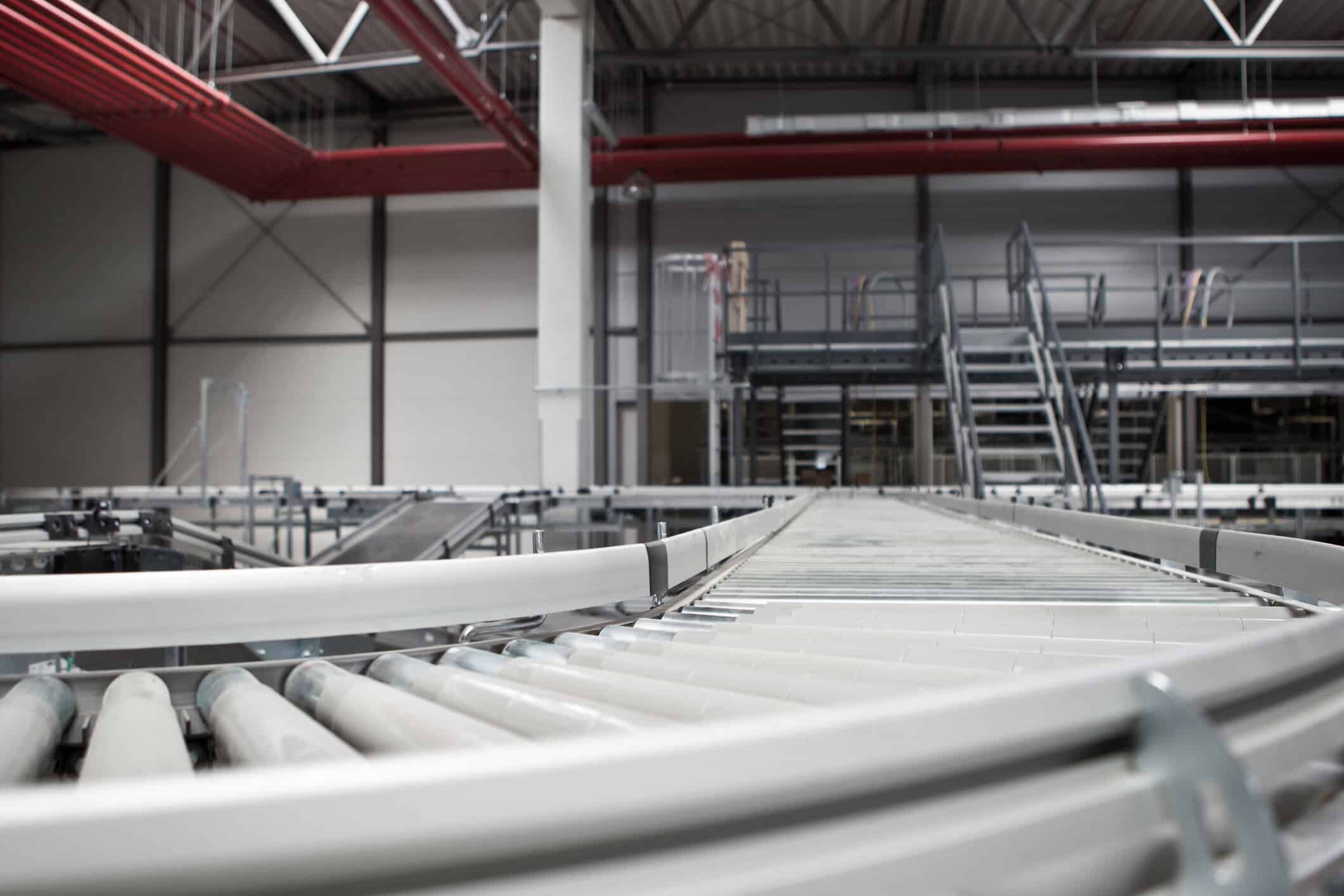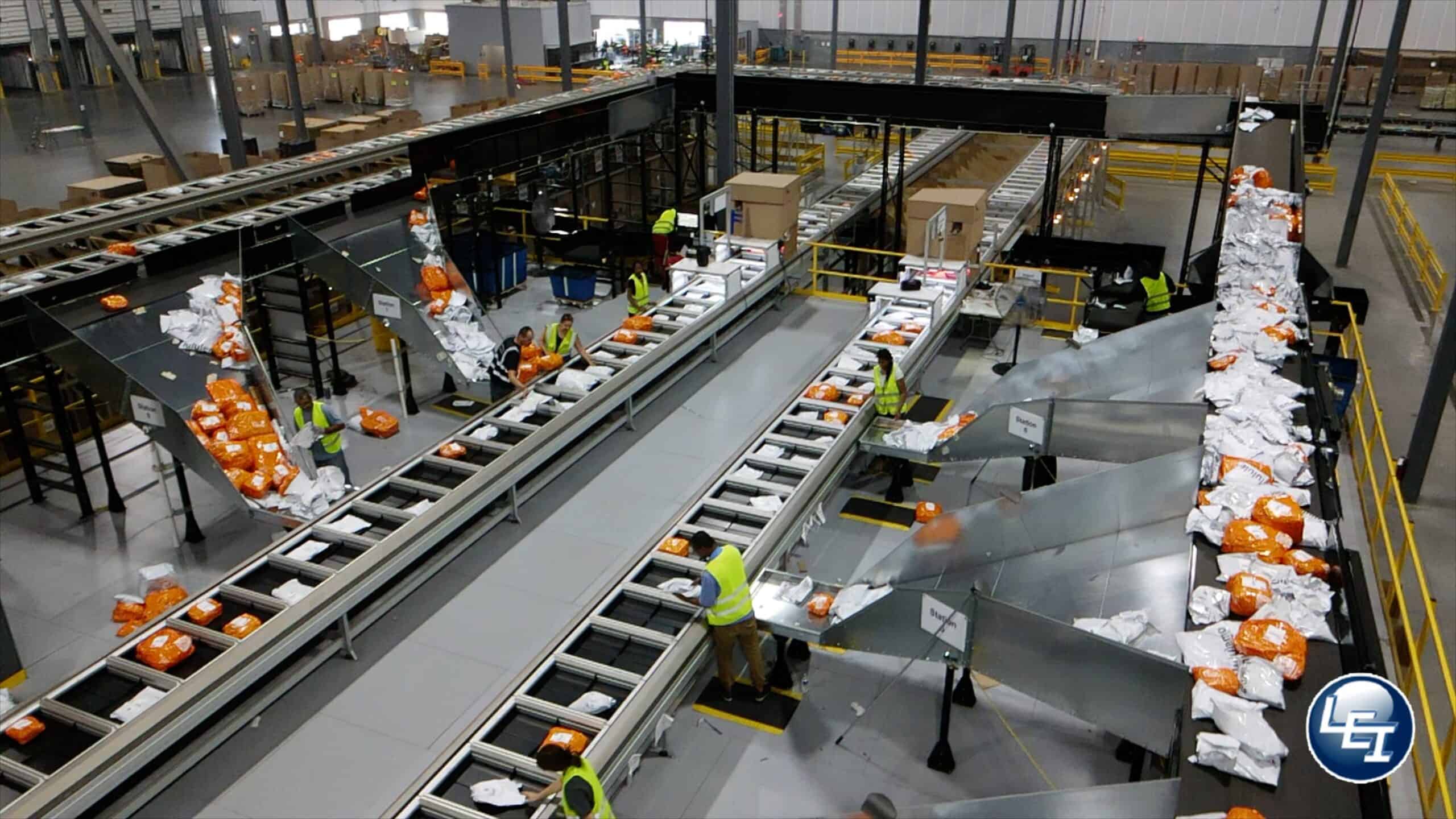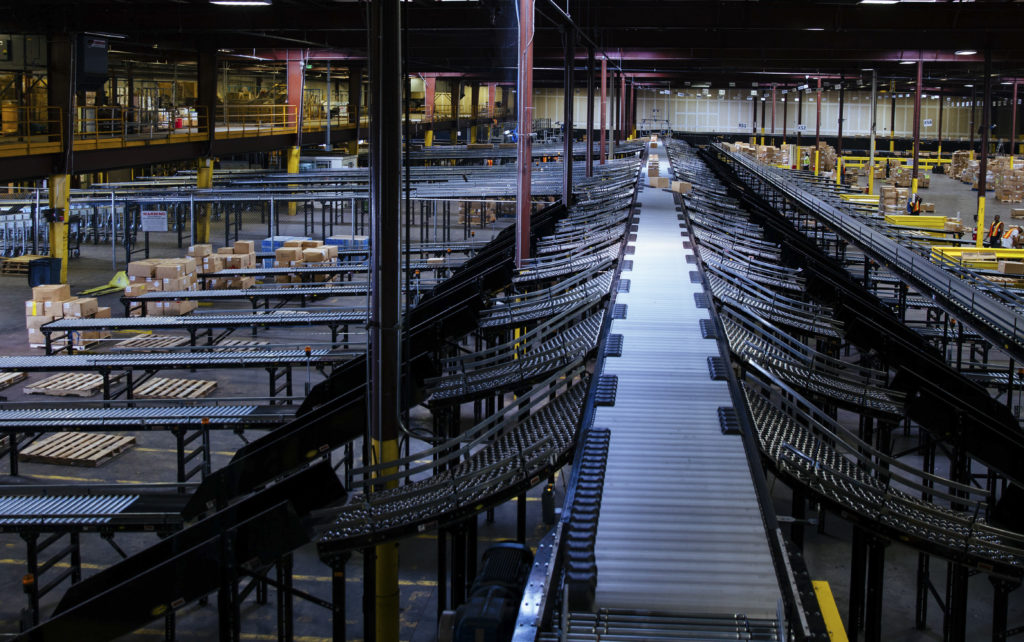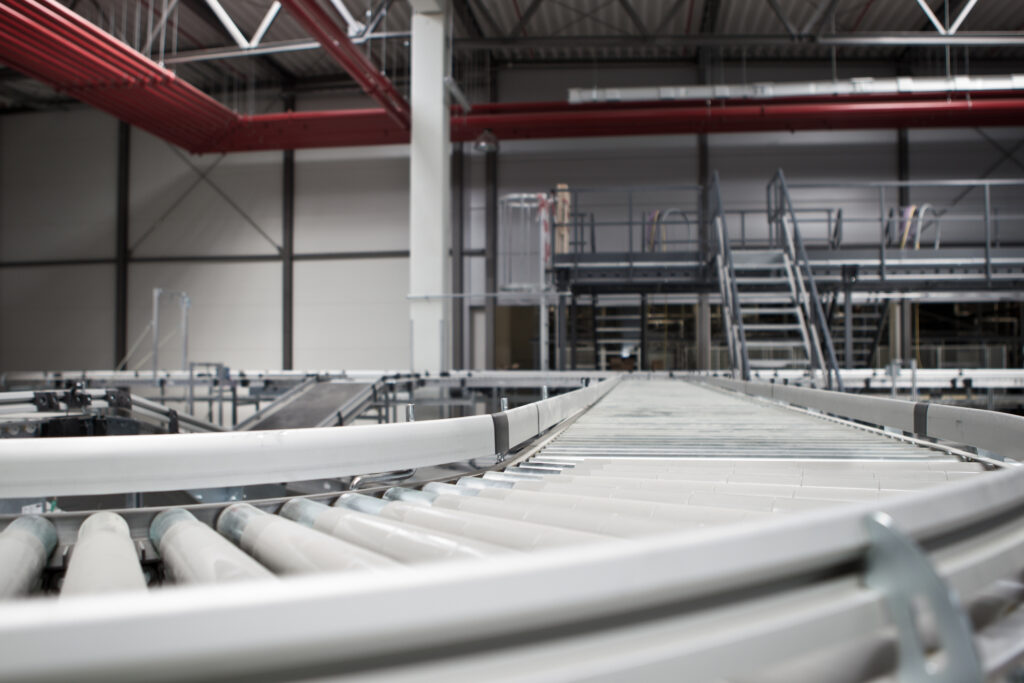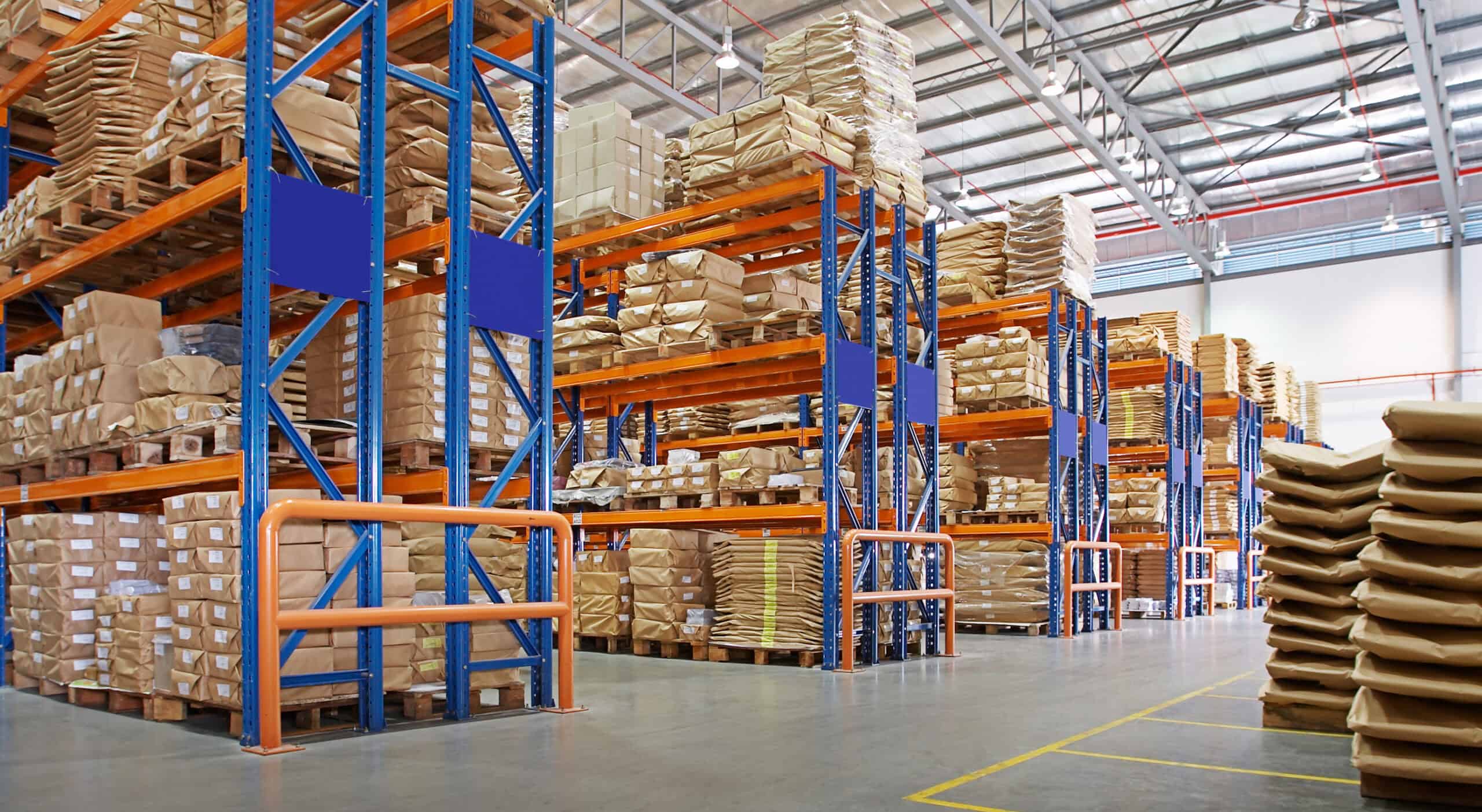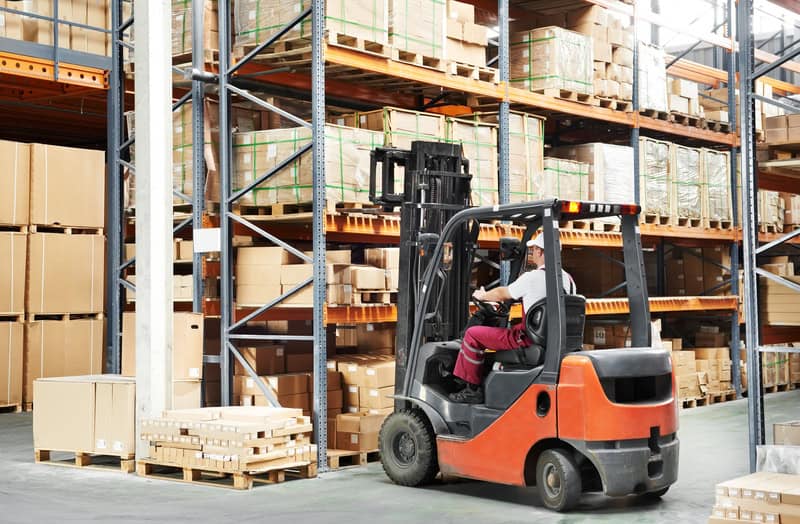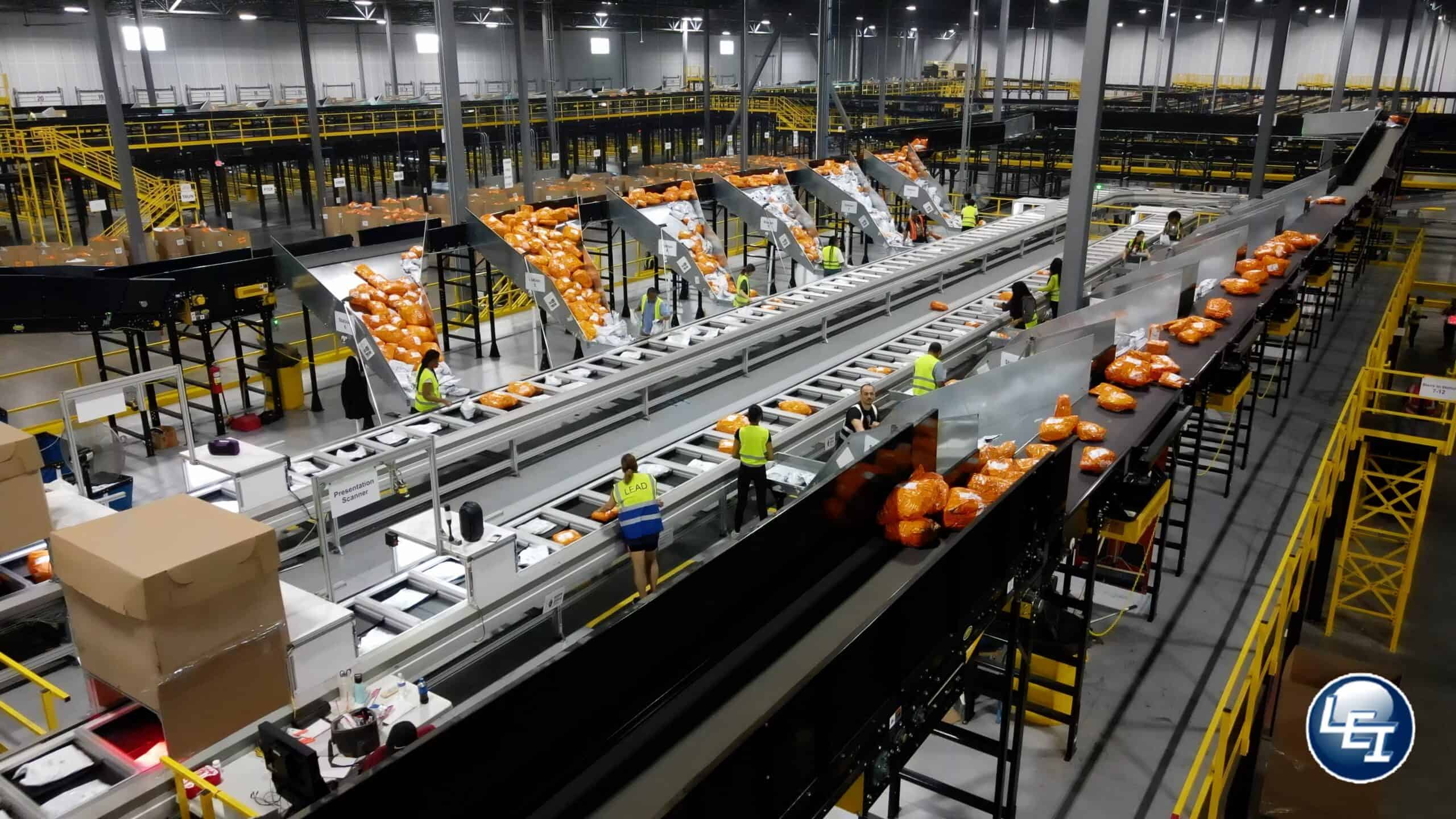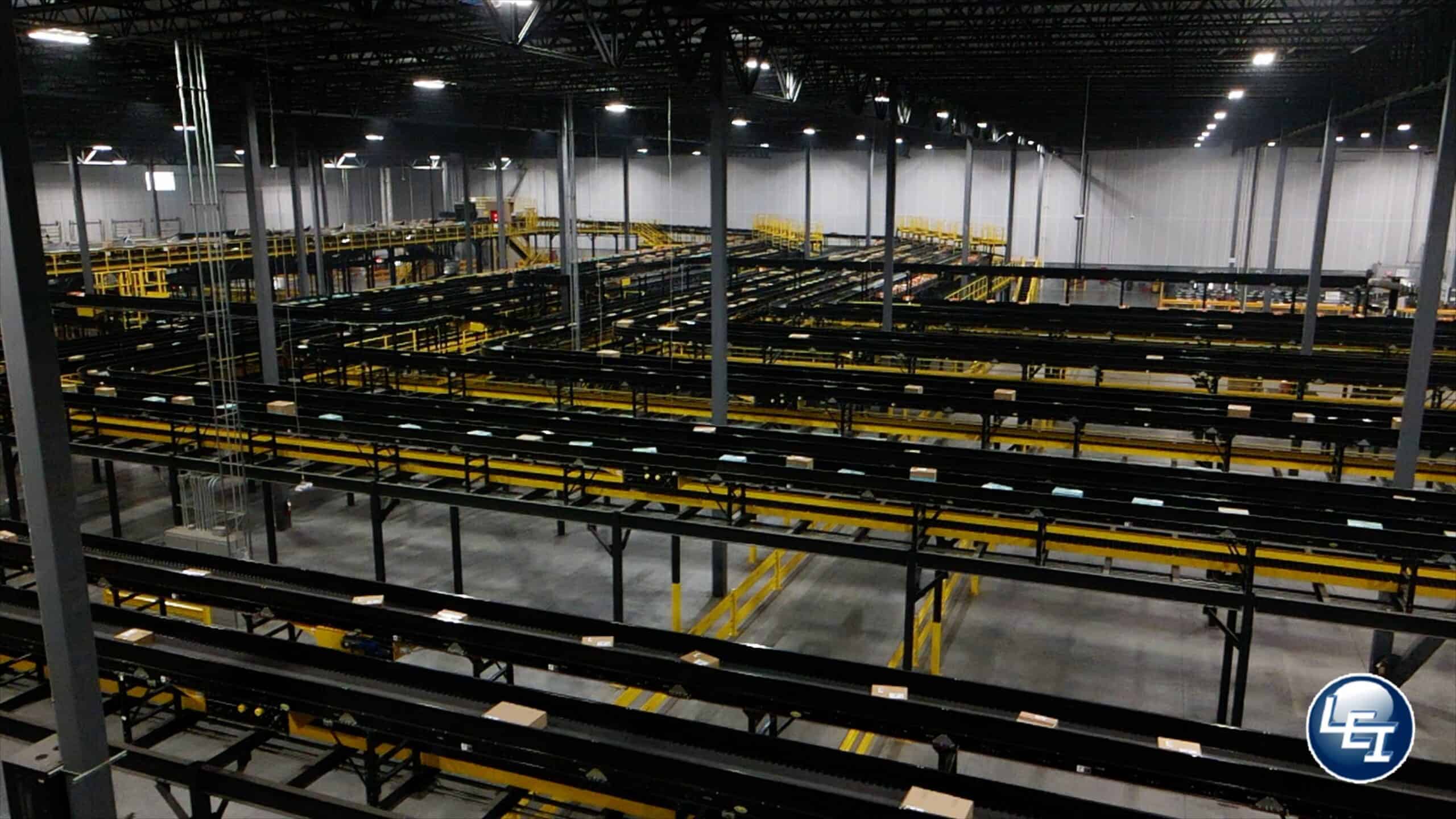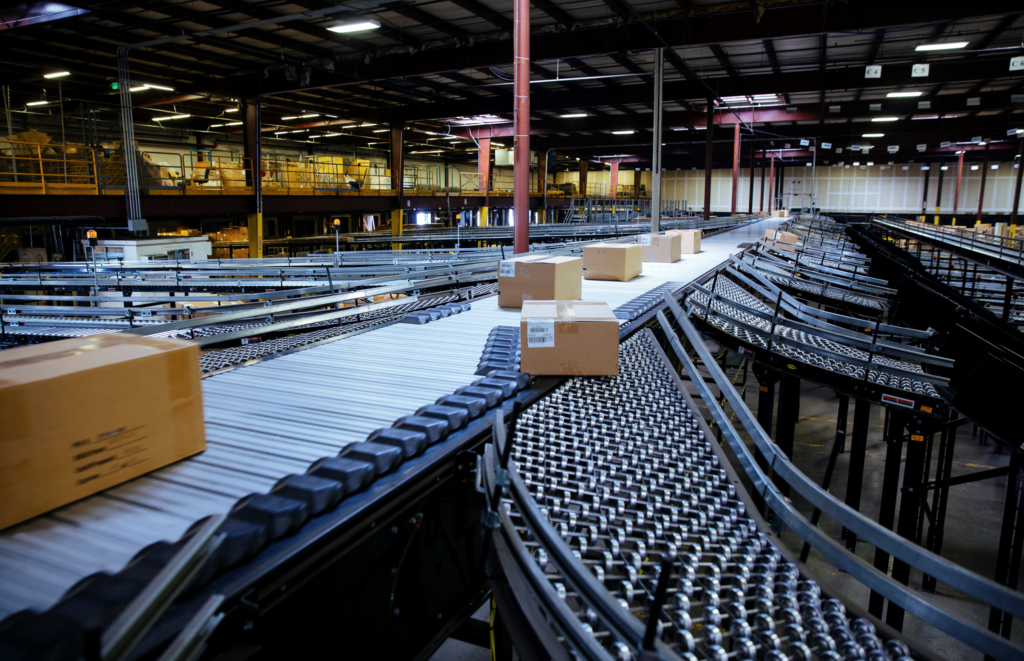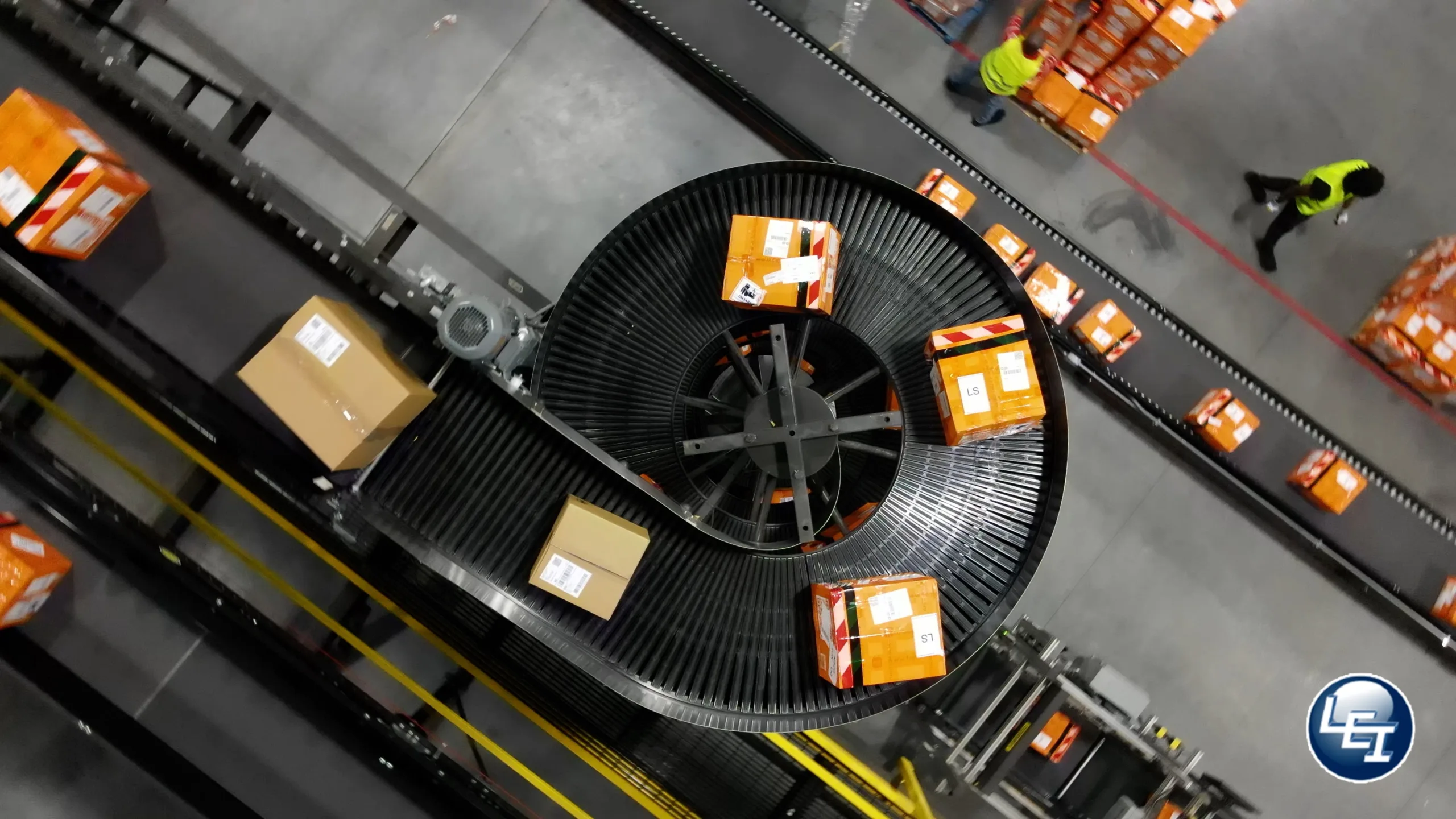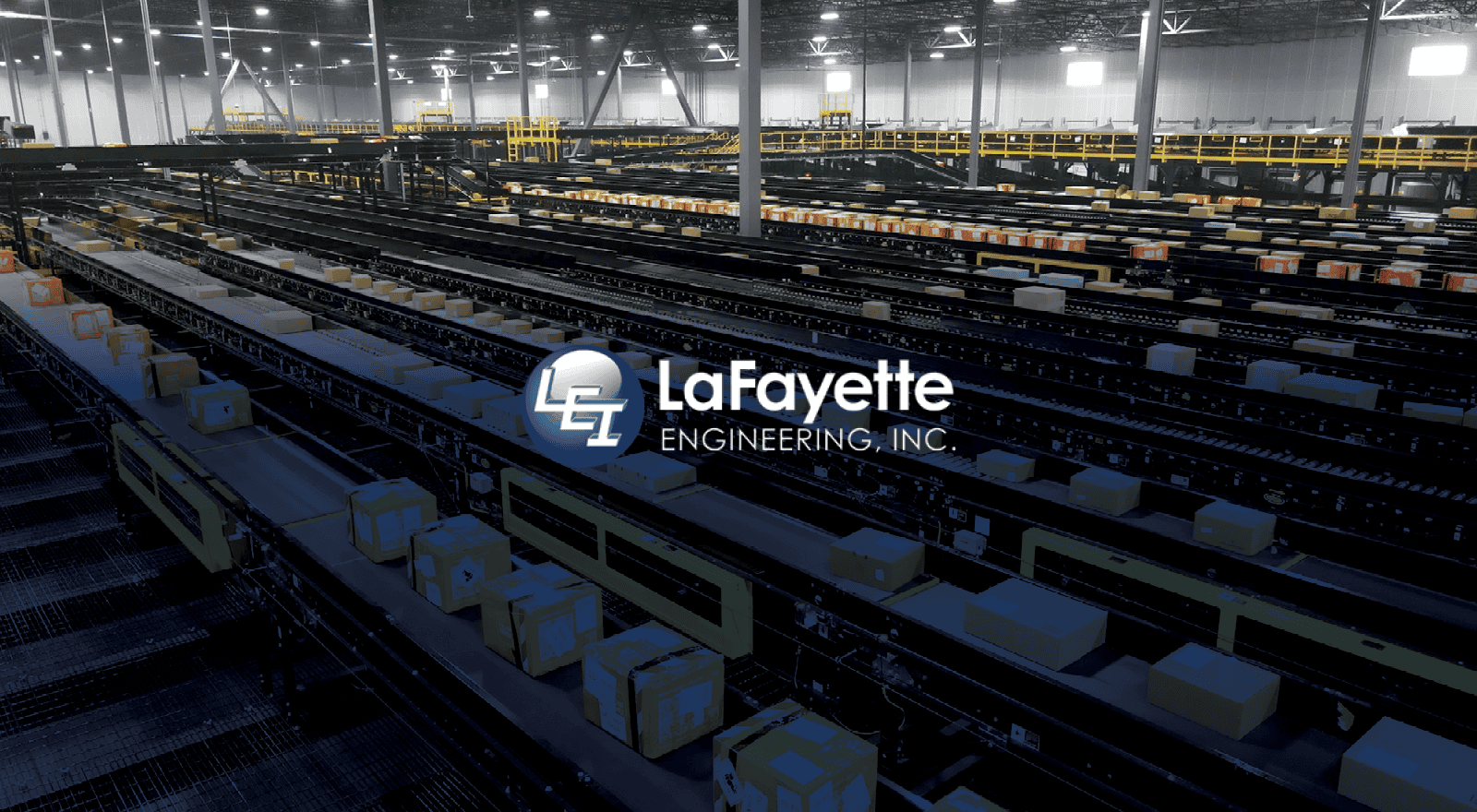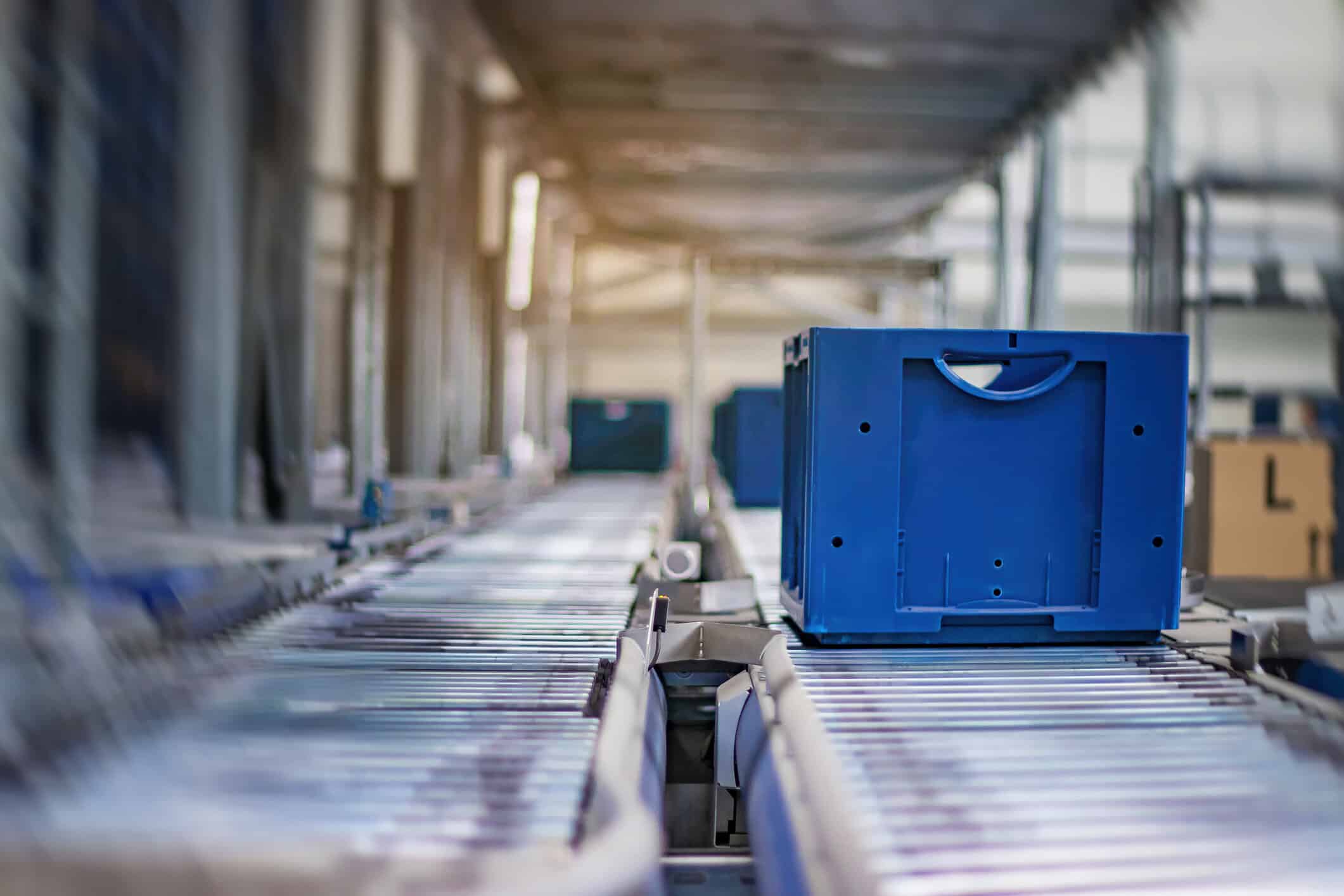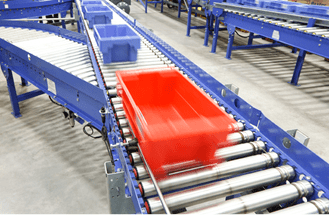Table of Contents
The warehouse conveyor systems industry is experiencing unprecedented transformation in 2025, driven by rapid technological advancement, evolving consumer expectations, and fundamental shifts in global supply chain strategies. As businesses adapt to an increasingly digital and demanding marketplace, conveyor systems have evolved from simple material transport mechanisms into intelligent, adaptive networks that form the backbone of modern automated warehouses. Lafayette Engineering, with over 35 years of leadership in the industry, provides unique insights into the trends shaping the future of warehouse conveyor systems and material handling automation.
This comprehensive analysis of warehouse conveyor systems industry trends for 2025 reveals how cutting-edge technologies, sustainable practices, and innovative design approaches are revolutionizing warehouse operations worldwide. From artificial intelligence integration to modular system architectures, these trends represent fundamental shifts that will define the next decade of warehouse automation and material handling excellence.
The Current State of the Warehouse Conveyor Systems Industry
Before examining emerging trends, it’s essential to understand the current landscape of the warehouse conveyor systems industry and the forces driving change.
Market Dynamics and Growth Drivers
The warehouse conveyor systems industry has experienced remarkable growth, with market valuations reaching new heights and expansion projections indicating continued robust demand:
E-commerce Expansion Impact: The continued growth of e-commerce has fundamentally altered warehouse operational requirements. Online retailers now demand conveyor systems capable of handling diverse product mixes, variable order volumes, and increasingly complex fulfillment requirements. This shift has driven innovation in flexible, adaptable conveyor technologies.
Labor Market Challenges: Persistent labor shortages across warehouse operations have accelerated automation adoption. Companies are investing heavily in conveyor systems that reduce manual handling requirements while improving operational efficiency and worker safety.
Supply Chain Resilience Focus: Recent global disruptions have highlighted the importance of resilient, flexible warehouse operations. Modern conveyor systems must adapt quickly to changing operational requirements and provide reliable performance during challenging periods.
Technology Integration Demands: Warehouse operators increasingly expect conveyor systems to integrate seamlessly with warehouse management systems, enterprise resource planning platforms, and emerging technologies like artificial intelligence and machine learning.
Lafayette Engineering has been at the forefront of addressing these market dynamics, developing innovative solutions that meet evolving customer requirements while anticipating future operational needs.
Technological Foundation for Innovation
The warehouse conveyor systems industry has built upon decades of mechanical and electrical engineering excellence to create the foundation for today’s intelligent systems:
Advanced Control Systems: Modern conveyor installations rely on sophisticated programmable logic controllers (PLCs) and warehouse control systems (WCS) that manage complex material flows with precision and reliability.
Sensor Technology Integration: Today’s conveyor systems incorporate multiple sensor technologies including barcode scanners, RFID readers, vision systems, and IoT devices that provide real-time visibility and control.
Modular Design Principles: Contemporary conveyor systems embrace modular design concepts that enable rapid reconfiguration, scalable expansion, and efficient maintenance procedures.
Integration Capabilities: Modern systems feature extensive integration capabilities that connect conveyor operations with broader warehouse management and enterprise systems.
Artificial Intelligence and Machine Learning Integration
The most significant trend shaping warehouse conveyor systems in 2025 is the deep integration of artificial intelligence and machine learning technologies that transform static material handling systems into adaptive, intelligent networks.
Predictive Analytics for System Optimization
AI-powered predictive analytics are revolutionizing how warehouse conveyor systems operate and are maintained:
Performance Prediction and Optimization: Machine learning algorithms analyze historical operational data, current system performance, and external factors to predict optimal conveyor configurations for different operational scenarios. These systems can automatically adjust speeds, routing logic, and capacity allocation to maximize throughput while minimizing energy consumption.
Predictive Maintenance Evolution: Advanced AI systems monitor conveyor performance continuously, analyzing vibration patterns, power consumption, and operational metrics to predict component failures before they occur. This capability reduces unplanned downtime by up to 75% while optimizing maintenance resource allocation.
Dynamic Route Optimization: Intelligent conveyor systems now use real-time data analysis to optimize product routing dynamically. These systems consider factors such as destination capacity, product characteristics, and current system loading to make routing decisions that minimize congestion and maximize efficiency.
Energy Consumption Optimization: AI algorithms analyze power consumption patterns and operational requirements to optimize energy usage automatically. These systems can reduce energy consumption by 20-30% through intelligent speed control, zone activation, and power management strategies.
Lafayette Engineering’s Conveyor Works platform has evolved to incorporate these AI capabilities, providing customers with intelligent systems that continuously improve performance through machine learning.
Autonomous Decision-Making Systems
2025 has seen the emergence of conveyor systems capable of autonomous decision-making without human intervention:
Self-Configuring Systems: Advanced conveyor networks can automatically reconfigure routing and operational parameters based on changing operational requirements. These systems adapt to seasonal volume fluctuations, product mix changes, and facility modifications without manual intervention.
Intelligent Exception Handling: AI-powered systems can identify and resolve common operational exceptions automatically. When products cannot be sorted normally, these systems implement alternative routing strategies or direct items to appropriate exception handling areas.
Adaptive Performance Management: Intelligent conveyor systems continuously monitor their own performance and make adjustments to maintain optimal operation. These systems can detect degrading performance and implement corrective measures before human operators notice issues.
Collaborative Intelligence: Modern conveyor systems communicate with other warehouse automation equipment to coordinate activities and optimize overall facility performance. This collaboration extends to robotic systems, automated storage and retrieval systems, and warehouse management platforms.
Real-Time Learning and Adaptation
The most advanced warehouse conveyor systems in 2025 feature real-time learning capabilities that enable continuous improvement:
Pattern Recognition: AI systems identify operational patterns and adapt conveyor performance accordingly. These systems learn from seasonal trends, product characteristics, and operational preferences to optimize performance continuously.
Continuous Optimization: Machine learning algorithms continuously refine system parameters based on operational experience. This ongoing optimization ensures that conveyor systems improve performance over time rather than degrading.
Adaptive User Interfaces: Intelligent systems provide personalized user interfaces that adapt to individual operator preferences and responsibilities. These interfaces present relevant information and controls while filtering unnecessary complexity.
Sustainable and Energy-Efficient Conveyor Technologies
Environmental responsibility and energy efficiency have become critical priorities in warehouse conveyor systems design, driving innovation in sustainable technologies and practices.
Green Technology Integration
The warehouse conveyor systems industry is embracing sustainable technologies that reduce environmental impact while improving operational efficiency:
Energy Recovery Systems: Advanced conveyor installations now incorporate regenerative braking and energy recovery technologies that capture energy from decelerating products and return it to the electrical system. These systems can recover 15-25% of energy consumption in high-throughput applications.
Solar Integration: Warehouse conveyor systems are increasingly designed to integrate with solar power installations. Intelligent energy management systems balance conveyor power requirements with solar generation and battery storage to minimize grid electricity consumption.
Low-Power Component Design: Manufacturers are developing conveyor components that require significantly less energy while maintaining performance. LED lighting, efficient motors, and optimized control systems contribute to overall energy reduction.
Smart Power Management: Intelligent power management systems automatically adjust conveyor operation to minimize energy consumption during low-demand periods. These systems can reduce energy usage by 30-40% through zone-based activation and intelligent speed control.
Lafayette Engineering has integrated sustainable design principles throughout our product portfolio, helping customers achieve both operational and environmental objectives.
Circular Economy Principles
The industry is adopting circular economy principles that minimize waste and maximize resource utilization:
Component Refurbishment Programs: Manufacturers now offer comprehensive refurbishment services that extend component life and reduce waste. These programs can extend conveyor system life by 25-50% while reducing replacement costs.
Recyclable Material Usage: New conveyor systems increasingly utilize recyclable materials in construction while maintaining durability and performance standards. This approach reduces environmental impact and supports end-of-life recycling.
Modular Design for Longevity: Modular conveyor designs enable component replacement and system reconfiguration without complete system replacement. This approach maximizes equipment value while minimizing waste.
Sustainable Manufacturing: Leading manufacturers are implementing sustainable manufacturing processes that reduce energy consumption, minimize waste, and utilize renewable energy sources.
Carbon Footprint Reduction Strategies
Warehouse conveyor systems are playing increasingly important roles in facility-wide carbon footprint reduction:
Optimized Material Flow: Intelligent conveyor systems minimize product travel distances and handling requirements, reducing energy consumption and operational carbon footprint.
Integration with Building Systems: Modern conveyor installations integrate with building management systems to optimize heating, cooling, and lighting based on operational requirements and occupancy patterns.
Transportation Optimization: Advanced conveyor systems enable more efficient warehouse operations that reduce transportation requirements and associated carbon emissions.
Lifecycle Carbon Assessment: Manufacturers are conducting comprehensive lifecycle carbon assessments to identify opportunities for emission reduction throughout the product lifecycle.
Modular and Flexible System Architectures
The demand for adaptable warehouse operations has driven significant innovation in modular and flexible conveyor system architectures that can evolve with changing business requirements.
Rapid Reconfiguration Capabilities
Modern warehouse conveyor systems feature design elements that enable rapid reconfiguration without major construction or extended downtime:
Plug-and-Play Components: Standardized interfaces and connection systems enable rapid installation and reconfiguration of conveyor sections. These systems can be reconfigured in hours rather than days or weeks.
Flexible Routing Networks: Advanced conveyor networks feature multiple routing options that can be activated or deactivated based on operational requirements. This flexibility enables facilities to adapt to changing product mixes and volume patterns.
Scalable Capacity: Modular conveyor designs enable capacity expansion through addition of parallel processing lines or extension of existing systems. This scalability supports business growth without complete system replacement.
Mobile and Temporary Solutions: The industry has developed mobile conveyor solutions that can be deployed temporarily for peak seasons or special projects. These systems provide flexibility for variable operational requirements.
Lafayette Engineering’s modular design philosophy enables customers to implement conveyor solutions that adapt to their evolving business requirements while protecting their technology investment.
Multi-Product Handling Flexibility
The diverse product characteristics in modern warehouses require conveyor systems capable of handling multiple product types effectively:
Variable Speed Control: Advanced conveyor systems feature zone-based speed control that optimizes handling for different product characteristics. Heavy items can move at different speeds than fragile products within the same system.
Adaptive Handling Methods: Intelligent conveyor systems automatically adjust handling methods based on product characteristics identified through scanning or RFID technology. This adaptation ensures optimal handling for each product type.
Configurable Sortation: Modern sortation systems can be reconfigured dynamically to accommodate different product mixes and destination requirements. This flexibility eliminates the need for separate systems for different product categories.
Mixed-Case Optimization: Advanced systems optimize handling for mixed-case scenarios where individual orders contain products with different characteristics and handling requirements.
Future-Ready Design Principles
The most successful warehouse conveyor systems in 2025 incorporate design principles that anticipate future technological evolution:
Technology Integration Readiness: Modern conveyor systems feature expansion capabilities that accommodate future technology integration without major system modifications.
Scalable Control Architecture: Advanced control systems can accommodate additional zones, sensors, and integration points as operational requirements evolve.
Standardized Communication Protocols: Industry-standard communication protocols ensure that conveyor systems can integrate with future warehouse management and automation technologies.
Upgrade Path Planning: Leading manufacturers provide clear upgrade paths that enable customers to enhance system capabilities over time while protecting their initial investment.
Advanced Sensor Technologies and IoT Integration
The warehouse conveyor systems industry has embraced Internet of Things (IoT) technologies and advanced sensors that provide unprecedented visibility and control over material handling operations.
Comprehensive Monitoring Ecosystems
Modern conveyor systems incorporate extensive sensor networks that monitor every aspect of system performance:
Vibration and Condition Monitoring: Advanced sensors continuously monitor conveyor mechanical condition, detecting early signs of wear, misalignment, or component failure. This monitoring enables predictive maintenance and prevents unexpected failures.
Environmental Monitoring: Integrated sensors track temperature, humidity, and air quality throughout conveyor systems. This monitoring ensures optimal operating conditions and identifies environmental factors that affect system performance.
Product Flow Analytics: Sophisticated sensor networks track individual products throughout conveyor systems, providing detailed analytics on flow patterns, bottlenecks, and optimization opportunities.
Energy Consumption Tracking: Smart energy meters and sensors provide detailed analysis of power consumption at the component level, enabling optimization and cost allocation for multi-tenant facilities.
Lafayette Engineering’s sensor integration expertise ensures that customers receive comprehensive monitoring capabilities that enhance both performance and reliability.
Real-Time Data Analytics and Visualization
The massive data streams generated by modern sensor networks require sophisticated analytics and visualization capabilities:
Dashboard and Visualization Tools: Advanced visualization platforms provide real-time insights into conveyor system performance through intuitive dashboards and reporting tools. These systems enable operators to identify issues quickly and make informed decisions.
Mobile Monitoring Capabilities: Mobile applications enable remote monitoring and control of conveyor systems, allowing managers and technicians to stay connected to operations from anywhere.
Augmented Reality Integration: Emerging AR technologies provide technicians with real-time system information and maintenance guidance overlaid on physical equipment. This technology improves maintenance efficiency and reduces training requirements.
Voice-Activated Controls: Advanced control systems now support voice commands for common operational tasks, enabling hands-free operation and improved safety.
Predictive Intelligence Networks
The integration of IoT technologies has enabled the development of predictive intelligence networks that anticipate operational requirements:
Demand Forecasting Integration: Conveyor systems now integrate with demand forecasting systems to anticipate volume requirements and optimize capacity allocation automatically.
Supply Chain Visibility: Advanced systems provide visibility into upstream supply chain activities, enabling proactive preparation for incoming inventory and shipments.
Weather and External Factor Integration: Intelligent systems consider weather forecasts and external factors that might affect operations, adjusting capacity and staffing recommendations accordingly.
Cross-Facility Coordination: Multi-site operations can coordinate conveyor system performance across facilities to optimize overall network efficiency and resource utilization.
Robotics Integration and Collaborative Automation
The convergence of conveyor systems with robotic technologies has created new possibilities for warehouse automation that combine the reliability of conveyor transport with the flexibility of robotic manipulation.
Seamless Human-Robot-Conveyor Collaboration
2025 has seen significant advancement in collaborative systems that integrate humans, robots, and conveyor systems:
Collaborative Picking Systems: Advanced systems combine conveyor transport with collaborative robots that assist human workers in picking operations. These systems improve productivity while maintaining the flexibility and decision-making capabilities of human workers.
Robotic Loading and Unloading: Intelligent robotic systems work seamlessly with conveyor networks to automate loading and unloading operations. These systems adapt to different product types and packaging configurations automatically.
Dynamic Task Allocation: Intelligent systems allocate tasks between human workers, robots, and conveyor automation based on real-time operational requirements and resource availability.
Safety Integration: Advanced safety systems ensure safe collaboration between humans and robotic systems within conveyor environments. These systems use multiple sensor technologies to monitor worker safety continuously.
Lafayette Engineering has developed expertise in integrating robotic systems with conveyor networks, providing customers with collaborative automation solutions that enhance both productivity and flexibility.
Autonomous Mobile Robot (AMR) Integration
The integration of conveyor systems with autonomous mobile robots has created flexible material handling networks:
Dynamic Routing Networks: AMRs work in conjunction with conveyor systems to create dynamic routing networks that adapt to changing operational requirements and facility layouts.
Last-Mile Delivery Integration: Conveyor systems now coordinate with AMRs to provide last-mile delivery within warehouse facilities, optimizing the handoff between fixed and mobile automation.
Inventory Management Coordination: Integrated systems coordinate conveyor operations with AMR-based inventory management, ensuring optimal product flow and inventory accuracy.
Flexible Capacity Management: The combination of conveyor systems and AMRs provides flexible capacity that can be scaled up or down based on operational requirements.
Robotic Maintenance and Service
Emerging robotic technologies are beginning to automate conveyor system maintenance and service activities:
Automated Inspection Systems: Robotic inspection systems can traverse conveyor networks to perform routine condition assessments and identify maintenance requirements.
Predictive Maintenance Robotics: Advanced robotic systems perform predictive maintenance tasks such as lubrication, cleaning, and minor adjustments based on condition monitoring data.
Emergency Response Automation: Robotic systems can respond to certain emergency situations automatically, implementing safety procedures and beginning corrective actions before human technicians arrive.
Remote Maintenance Capabilities: Robotic systems enable remote maintenance activities that reduce the need for on-site technical personnel while maintaining system performance.
Enhanced Safety and Security Features
Safety and security have become paramount concerns in warehouse conveyor systems design, driving innovation in technologies that protect both workers and assets.
Advanced Worker Safety Systems
Modern conveyor systems incorporate multiple layers of safety technology that go beyond traditional guards and barriers:
Intelligent Safety Monitoring: Advanced sensor networks monitor worker proximity and movement around conveyor systems, automatically adjusting system operation to maintain safe conditions.
Wearable Technology Integration: Smart safety equipment provides real-time location tracking and hazard detection for workers in conveyor environments. These systems can automatically trigger safety responses when potential hazards are detected.
Ergonomic Optimization: Modern conveyor designs incorporate ergonomic principles that reduce worker strain and injury risk. Adjustable heights, optimal positioning, and reduced reaching requirements contribute to safer work environments.
Emergency Response Systems: Sophisticated emergency response systems can isolate affected conveyor sections quickly while maintaining operation in unaffected areas. These systems minimize the impact of emergencies on overall operations.
Lafayette Engineering prioritizes safety in all system designs, ensuring that customers receive conveyor solutions that protect workers while maintaining operational efficiency.
Cybersecurity and Data Protection
As conveyor systems become increasingly connected and intelligent, cybersecurity has become a critical consideration:
Secure Communication Protocols: Modern conveyor control systems utilize encrypted communication protocols that protect against cyber attacks and unauthorized access.
Access Control Systems: Advanced access control systems ensure that only authorized personnel can modify conveyor system configurations or access sensitive operational data.
Data Encryption and Protection: Comprehensive data protection measures safeguard operational information and prevent unauthorized access to proprietary processes and information.
Cybersecurity Monitoring: Continuous cybersecurity monitoring identifies potential threats and implements protective measures automatically.
Asset Protection and Loss Prevention
Enhanced security features protect valuable inventory and equipment throughout conveyor systems:
Video Analytics Integration: Advanced video analytics systems monitor conveyor operations continuously, identifying unusual activities or potential security threats automatically.
RFID and Tracking Technologies: Comprehensive tracking systems monitor individual products throughout conveyor networks, preventing loss and enabling rapid location of missing items.
Tamper Detection: Sophisticated tamper detection systems identify unauthorized access attempts or system modifications, triggering appropriate security responses.
Integration with Facility Security: Conveyor security systems integrate with broader facility security platforms to provide comprehensive protection for warehouse operations.
Cloud-Based Control and Monitoring Systems
The migration to cloud-based platforms has transformed how warehouse conveyor systems are controlled, monitored, and managed, enabling new levels of flexibility and capability.
Scalable Cloud Architecture
Cloud-based conveyor control systems provide unprecedented scalability and flexibility:
Elastic Computing Resources: Cloud platforms automatically scale computing resources based on operational requirements, ensuring optimal performance during peak periods while minimizing costs during normal operations.
Global Accessibility: Cloud-based systems enable remote monitoring and management from anywhere in the world, supporting global operations and remote technical support.
Real-Time Collaboration: Multiple stakeholders can access system information simultaneously, enabling enhanced collaboration between operations, maintenance, and management teams.
Disaster Recovery Capabilities: Cloud platforms provide robust disaster recovery capabilities that ensure business continuity even during significant system failures or natural disasters.
Lafayette Engineering’s cloud-enabled Conveyor Works platform provides customers with scalable, reliable control systems that grow with their operational requirements.
Advanced Analytics and Machine Learning
Cloud platforms enable sophisticated analytics and machine learning capabilities that would be impractical with on-premises systems:
Big Data Processing: Cloud platforms can process massive amounts of operational data to identify trends, patterns, and optimization opportunities that would be impossible to detect manually.
Machine Learning Model Development: Cloud-based machine learning platforms enable the development and deployment of custom optimization models tailored to specific operational requirements.
Comparative Analytics: Cloud systems can compare performance across multiple facilities and operations, identifying best practices and improvement opportunities.
Predictive Modeling: Advanced predictive models forecast future operational requirements and system performance, enabling proactive planning and optimization.
Integration and Connectivity
Cloud-based systems provide enhanced integration capabilities that connect conveyor operations with broader business systems:
Enterprise System Integration: Cloud platforms facilitate integration with enterprise resource planning, customer relationship management, and financial systems, providing comprehensive business visibility.
Supply Chain Connectivity: Advanced integration capabilities connect conveyor operations with suppliers, customers, and logistics partners, enabling end-to-end supply chain optimization.
API-First Architecture: Modern cloud platforms provide comprehensive APIs that enable custom integrations and application development.
Real-Time Data Sharing: Cloud systems enable real-time data sharing with stakeholders throughout the supply chain, improving coordination and decision-making.
Industry 4.0 and Smart Factory Integration
The warehouse conveyor systems industry is embracing Industry 4.0 principles that integrate physical systems with digital technologies to create intelligent, adaptive manufacturing and distribution networks.
Digital Twin Technologies
Digital twin implementations are revolutionizing how warehouse conveyor systems are designed, operated, and optimized:
Virtual System Modeling: Digital twins provide comprehensive virtual models of conveyor systems that enable simulation, testing, and optimization before implementing changes in physical systems.
Real-Time Synchronization: Advanced digital twins maintain real-time synchronization with physical systems, providing accurate virtual representations that enable remote monitoring and analysis.
Predictive Simulation: Digital twin platforms can simulate future operational scenarios and test optimization strategies without affecting actual operations.
Training and Education: Virtual systems provide safe, realistic environments for training operators and technicians without risking equipment damage or operational disruption.
Lafayette Engineering utilizes digital twin technologies throughout the design and implementation process, ensuring optimal system performance and providing customers with valuable tools for ongoing optimization.
Cyber-Physical System Integration
Modern warehouse conveyor systems exemplify cyber-physical systems that seamlessly blend physical and digital capabilities:
Autonomous Operation: Advanced cyber-physical systems can operate autonomously while maintaining coordination with human operators and other automated systems.
Adaptive Response: These systems adapt automatically to changing conditions, optimizing performance based on real-time operational requirements and external factors.
Self-Optimization: Intelligent systems continuously optimize their own performance through machine learning and adaptive algorithms.
Distributed Intelligence: Modern systems distribute intelligence throughout the network rather than relying on centralized control, improving resilience and responsiveness.
Smart Manufacturing Ecosystem Integration
Warehouse conveyor systems are increasingly integrated with broader smart manufacturing ecosystems:
Production Planning Integration: Conveyor systems coordinate with production planning systems to optimize material flow based on manufacturing schedules and requirements.
Quality Management Integration: Advanced systems integrate with quality management platforms to ensure that only acceptable products proceed through the distribution network.
Supply Chain Orchestration: Intelligent conveyor systems participate in supply chain orchestration platforms that coordinate activities across multiple facilities and partners.
Customer Integration: Some advanced systems provide customers with real-time visibility into order status and delivery timelines through integrated platforms.
Future Outlook: What’s Next for Warehouse Conveyor Systems
As we look beyond 2025, several emerging trends and technologies promise to further transform the warehouse conveyor systems industry.
Emerging Technologies on the Horizon
Quantum Computing Applications: Quantum computing may eventually enable optimization capabilities that are impossible with classical computers, potentially revolutionizing routing algorithms and system design.
Advanced Materials: New materials with superior strength-to-weight ratios, self-healing properties, or integrated sensing capabilities could transform conveyor design and performance.
Holographic Displays: Advanced display technologies may provide new interfaces for system monitoring and control that improve operator efficiency and decision-making.
Brain-Computer Interfaces: Emerging interface technologies could eventually enable direct mental control of conveyor systems, though practical applications remain years away.
Societal and Economic Trends
Sustainability Imperatives: Increasing focus on environmental responsibility will continue driving innovation in energy-efficient and sustainable conveyor technologies.
Labor Evolution: The changing nature of work will require conveyor systems that enhance human capabilities rather than simply replacing workers.
Urbanization Challenges: Growing urban populations will drive demand for more efficient distribution systems that operate in space-constrained environments.
Economic Uncertainty: Economic volatility will increase demand for flexible, adaptable conveyor systems that can accommodate changing business conditions.
Technology Convergence
The most significant future developments will likely emerge from the convergence of multiple technologies:
AI-Robotics-Conveyor Integration: The deep integration of artificial intelligence, robotics, and conveyor systems will create unprecedented capabilities for adaptive, intelligent material handling.
5G and Edge Computing: High-speed, low-latency communications will enable new levels of real-time coordination and control.
Blockchain Integration: Distributed ledger technologies may enable new approaches to supply chain transparency and coordination.
Augmented Reality Evolution: Advanced AR technologies will transform how operators interact with conveyor systems and perform maintenance activities.
Lafayette Engineering: Leading the Future of Warehouse Conveyor Systems
As the warehouse conveyor systems industry continues its rapid evolution, Lafayette Engineering remains at the forefront of innovation, helping customers navigate technological change while achieving their operational objectives.
Innovation and Development Leadership
Lafayette Engineering’s commitment to innovation ensures that customers receive access to the latest technologies and capabilities:
Research and Development Investment: Continuous investment in R&D enables the development of next-generation conveyor technologies that address emerging market requirements.
Technology Partnerships: Strategic partnerships with technology leaders ensure access to cutting-edge capabilities and integration opportunities.
Customer Collaboration: Close collaboration with customers drives innovation that addresses real operational challenges and opportunities.
Industry Leadership: Active participation in industry organizations and standards development helps shape the future direction of warehouse automation technology.
Comprehensive Solution Portfolio
Lafayette Engineering’s comprehensive portfolio addresses the full spectrum of warehouse conveyor system requirements:
Advanced Sortation Technologies: Proprietary technologies like Lafayette Magnetic Sortation (LMS) provide customers with competitive advantages through superior performance and flexibility.
Intelligent Control Systems: The Conveyor Works platform incorporates the latest advances in artificial intelligence, machine learning, and cloud computing.
Integration Expertise: Comprehensive integration capabilities ensure that conveyor systems work seamlessly with existing and future warehouse technologies.
Service Excellence: Nationwide service capabilities provide customers with reliable support throughout the system lifecycle.
Partnership Approach
Lafayette Engineering’s partnership approach ensures that customers receive solutions that deliver long-term value:
Consultative Design Process: Collaborative design processes ensure that solutions address specific customer requirements and constraints.
Lifecycle Support: Comprehensive support services help customers optimize system performance throughout the equipment lifecycle.
Technology Evolution: Upgrade paths and technology refresh programs help customers stay current with technological advancement.
Performance Optimization: Ongoing optimization services ensure that systems continue to deliver value as operational requirements evolve.
Conclusion: Embracing the Future of Warehouse Automation
The warehouse conveyor systems industry in 2025 represents a fascinating convergence of mechanical engineering excellence, advanced digital technologies, and innovative design thinking. The trends discussed in this comprehensive analysis demonstrate how the industry continues to evolve in response to changing market demands, technological capabilities, and operational requirements.
Organizations that embrace these trends and partner with innovative technology providers like Lafayette Engineering will be well-positioned to thrive in an increasingly competitive marketplace. The key to success lies in understanding how these trends intersect with specific operational requirements and implementing solutions that provide both immediate value and long-term strategic advantages.
Key Takeaways for Industry Professionals
Technology Integration is Essential: The most successful warehouse operations will be those that effectively integrate conveyor systems with broader automation and information technologies.
Flexibility Enables Success: Modular, adaptable conveyor systems provide the flexibility needed to respond to changing market conditions and operational requirements.
Sustainability Drives Innovation: Environmental responsibility and energy efficiency are becoming competitive advantages that influence customer purchasing decisions.
Human-Centric Design Matters: The most effective automation solutions enhance human capabilities rather than simply replacing workers.
Partnership Approach is Critical: Success requires partnerships with technology providers who understand both current requirements and future trends.
Taking Action: Preparing for the Future
The rapid pace of change in the warehouse conveyor systems industry requires proactive planning and strategic thinking. Organizations should:
- Assess Current Capabilities: Evaluate existing conveyor systems against emerging industry trends and future requirements
- Develop Technology Roadmaps: Create strategic plans for technology evolution and system enhancement
- Invest in Training: Ensure that staff members have the skills needed to operate and maintain advanced conveyor technologies
- Choose Strategic Partners: Select technology providers who demonstrate innovation leadership and long-term commitment to customer success
- Plan for Flexibility: Implement systems and processes that can adapt to future technological and operational changes
Contact Lafayette Engineering: Your Partner for Future Success
Lafayette Engineering stands ready to help organizations navigate the evolving landscape of warehouse conveyor systems and automation technology. Our expertise, innovation, and commitment to customer success make us the ideal partner for businesses seeking to capitalize on industry trends and achieve operational excellence.
Ready to explore how these industry trends can benefit your operation?
Phone: (844) 845-7580
Website: www.lafayette-engineering.com
Email: Contact us through our website for immediate response
Our team of experts will work with you to:
- Evaluate how industry trends apply to your specific operational requirements
- Design solutions that incorporate the latest technologies and best practices
- Develop implementation strategies that minimize risk while maximizing benefits
- Provide ongoing support ensuring long-term success and optimization
The future of warehouse automation is exciting, filled with possibilities for enhanced efficiency, improved sustainability, and unprecedented operational capabilities. Partner with Lafayette Engineering to ensure that your organization is ready to embrace this future and achieve the competitive advantages that advanced conveyor technology can provide.
About Lafayette Engineering
Since 1989, Lafayette Engineering has been the trusted leader in warehouse conveyor systems design, implementation, and support. Our commitment to innovation, customer success, and technological excellence has helped hundreds of clients across the United States transform their operations and achieve their strategic objectives.
With headquarters in Danville, Kentucky, and service locations throughout the country, Lafayette Engineering combines deep industry expertise with comprehensive service capabilities to deliver solutions that drive measurable business results. From cutting-edge sortation technologies to intelligent control systems, we provide the innovation and support that enable operational excellence.
Visit lafayette-engineering.com to learn more about our comprehensive solutions and discover how we can help your organization capitalize on the latest industry trends and achieve sustainable competitive advantages.

